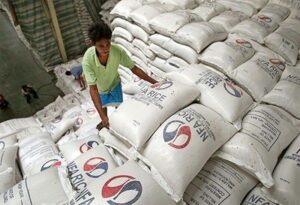THE Department of Agriculture (DA) said it is aiming for a year-end national rice inventory level of 3.64 million metric tons (MMT), after a reading of just over 2 MMT in early May.
“At the end of the year we are looking at 3.64 MMT, equivalent to nearly 95 days’ demand,” Agriculture Assistant Secretary for Operations U-Nichols A. Manalo said in a briefing.
The national rice inventory rose 10.3% year on year in early May, while corn stocks were up 6.3%, the Philippine Statistics Authority (PSA) said.
In a report, the PSA said the rice inventory was estimated at 2.08 MMT, noting declines in volume held by the National Food Authority and households.
Mr. Manalo added that palay or unmilled rice production was estimated at 8.8 MMT during the first half of the year.
The DA said overall palay production could hit 20.44 MMT this year. This was a downgrade from the initial 20.8 MMT projection to account for the possible effects of El Niño and La Niña.
In a separate report, the PSA said that palay production may have dropped 8.4% year on year to 3.89 MMT during the second quarter.
The government weather service, known as PAGASA (Philippine Atmospheric, Geophysical and Astronomical Services Administration), has declared El Niño to have ended, and estimated the chances of La Niña setting in between July and September at 69%.
“Historically, the damage is greater during La Niña …during rains and typhoons (the damage can hit) 500 to 600 thousand MT,” Agriculture Assistant Secretary and Spokesperson Arnel V. de Mesa said on the sidelines of the briefing.
La Niña event increases the likelihood of above-normal rainfall in parts of the country, especially towards the end of the year.
He added that water management may be difficult during the La Niña months.
“It is more difficult to control, especially if there is too much water (beyond the capacity of flood-control systems),” Mr. De Mesa said.
La Niña may also lead to increased rice imports.
“It is possible that there will be an increase (in imports) especially with a severe La Niña,” he added.
Rice imports amounted to 2.17 MMT as of June 6, according to the Bureau of Plant Industry.
The US Department of Agriculture has upwardly revised its rice import forecast for the Philippines to 4.6 MMT this year, owing to higher consumption and lowered import tariffs.
The National Economic and Development Authority Board has approved a plan to lower tariffs on industrial and farm goods, including the further reduction of rice import tariffs to 15% from 35%, until 2028. — Adrian H. Halili






